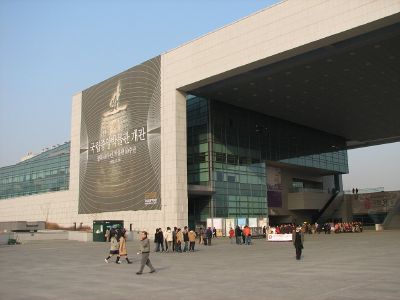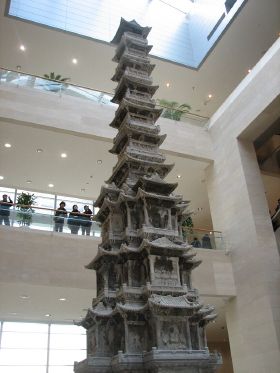National Museum of Korea
The National Museum of Korea is the flagship museum of Korean history and art in South Korea and is the cultural organization that represents Korea. It was first established in 1945. In October of 2005, the museum opened in a new building in Yongsan Family Park in Seoul, South Korea. The museum contains over 150,000 pieces in its collection with 11,000 on display at one time. It is the largest museum in Asia and the sixth-largest museum in the world in terms of floor space, covering 307,227 square feet.
Measures to protect the treasures inside the museum included designing a building built to withstand a magnitude 6.0 Richter Scale earthquake. The display cases for artifacts are equipped with seismic-protective platforms which absorb shocks and trembles. There is also an imported natural lighting system which utilizes sunlight instead of artificial lights and an air purification system designed to protect the art and artifacts of the museum. The museum is also made from fire resistant materials.
To design the new building, the Korean government held an international competition open to architects around the world to submit a proposal for the new building. There were over 854 entries from 59 countries. The winning design was inspired by the idea of a traditional Korean fortress and was submitted by Chang-Il Kim of Junglim Architects & Engineers Ltd.
The building is oblong, like a Korean fortress, at 404 meters in length. It is six-stories in height and is surrounded by indigenous plants and gardens.
History
Emperor Sunjong established Korea's first museum, the Imperial Household Museum, in 1908 C.E. in the waning days of the Joseon Dynasty. The collection of the Imperial Household Museum at Changgyeonggung and the later Japanese Government General Museum, during the Japanese rule of Korea, became the nucleus of the National Museum's collection which was established when South Korea gained independence in 1945 C.E. During the Korean War, the 20,000 of the museum's pieces were safely moved to Busan to avoid destruction. When the museum came back to Seoul after the war it was housed at both Gyeongbokgung and Deoksugung Palace. In 1972, the museum moved again to a new building on the grounds of the Gyeonbokgung palace. The museum was moved again in 1986 to the Jungangcheong, the former Japanese General Government Building, which housed the museum until it was demolished 1995.
Layout of the Museum
The museum is divided into three floors. Symbolically, the left of the museum is supposed to represent the past while the right side of the museum represents the future.
The first floor contains the Archaeological Gallery which contain approximately 4,500 artifacts from the Paleolithic to the Balhae era. The ten exhibition rooms in the gallery are the Paleolithic Room, Neolithic Room, Bronze Age & Early Iron Age Room, Proto Three Kingdoms Room, Goguryeo Room, Baekje Room, Gaya Room, Silla Room, Unified Silla Room, and Balhae Room. Information about and artifacts from important prehistoric sites and settlements such the Bangudae Petroglyphs and Songgung-ni are found in the Neolithic and Bronze Age Rooms.
Also on the first floor is the Historical Gallery which contains recorded and historical documents such as Hangul inscriptions, maps, and other valuable documents. The nine rooms of the gallery are the Hangeul Room, Prints Room, Inscriptions Room, Documents Room, Map Room, King and His Reign Room, Socio-economic Life Room, Traditional Thoughts Room, and Foreign Relations Room.
The second floor contains the Fine Arts Gallery I and the Donation Gallery. The Fine Arts Gallery I contains 890 pieces of art in four rooms that explore the traditional and religious arts of Korea in line and color. The rooms are the Painting Room, Calligraphy Room, Buddhist Paintings Room, and Wooden Craft Room.
The Donation Gallery holds 1000 pieces of art from a wide variety of cultures donated from the private collections of collectors. The rooms are the Lee Hong-kun Collection Room, Other Collections Room, Kim Chong-hak Collection Room, Yu Kang-yul Collection Room, Park Young-sook Collection Room, Choi Young-do Collection Room, Park Byong-rae Collection Room, Yoo Chang-jong Collection Room, Kaneko Kazushige Collection Room, Hachiuma Tadasu Collection Room, and Luchi Isao Collection Room.
The third floor contains the Fine Arts Gallery II and contains 630 pieces that represent Korean Buddhist sculpture and craftwork. Highlights of the gallery include Goryeo Celadon wares and National Treasure of Korea No. 83, the world-renowned Bangasayusang (or meditating Maiterya). The five rooms of the gallery are the Metal Arts Room, Celadon Room, Buncheong Ware Room, White Porcelain Room, and Buddhist Sculpture Room.
Finally, also on the third floor, is the Asian Arts Gallery which contains 970 pieces which explores the similarities and divergences of Asian Art and the confluence of Asian and Western art via the Silk Road. The six rooms are the Indonesian Art Room, Central Asian Art Room, Chinese Art Room, Relics from Sinan Seabed Room, Nangnang Remains Room, and Japanese Art Room.
The grounds of the museum contain parks, gardens of indigenous plants, waterfalls and pools, a collection of pagodas and other outdoor Korean art.
Treasures from Pyongyang Exhibit
Currently 90 significant cultural artifacts are on display at the National Museum of Korea which were loaned by the Korean Central History Museum in Pyongyang. The artifacts will stay until August 16, 2006 and will then move to the Taegu National Museum from August 28 to October 26. The exhibit was designed to engender other cultural property exchanges between the two Koreas. Of note is the bird bone flute from 2000 B.C.E. which is the oldest extant musical instrument from Korea. [1]. The most important item loaned is a bronze statue of Wang Geon, the first king of the Goryeo Dynasty. The statue is 138.3 centimeter in height and was excavated in 1992 at his mausoleum in Kaesong. The statue was believed to have originally been dressed in royal clothes but those have since disappeared. Famous paintings from the Joseon Dynasty are also on loan.
Gallery
Joseon Dynasty vase.
- Baekjeincenseburner2.jpg
A replica of the Gilt-bronze Incense Burner of Baekje is on display at the museum
How to Visit
- Metro Line 4 and Yongsan-Deokso Line, Ichon Station (Exit 2,1)
- Rapid bus (red) : 9502 get off at Ichon Station
- Branch bus (green) : 0211 get off at Ichon Station
See also
- List of Korea-related topics
- List of museums
ReferencesISBN links support NWE through referral fees
http://news.sawf.org/Travel/3572.aspx
http://www.korea-is-one.org/article.php3?id_article=2415
External links
- National Museum of Korea. Retrieved July 2, 2007.
- Life in Korea, Korea Travel Guide. Retrieved July 2, 2007.
- UIA, The National Museum of Korea in Seoul. Retrieved July 2, 2007.
- Korean National Heritage Online, National Museum of Korea. Retrieved July 2, 2007.
- Yonhap News (keep hitting reload until the article shows).
- Korea Times (Images of some of the items from North Korea).
- Archaeology News, National Museum Poised to Open in New Home. Retrieved July 2, 2007.
Credits
New World Encyclopedia writers and editors rewrote and completed the Wikipedia article in accordance with New World Encyclopedia standards. This article abides by terms of the Creative Commons CC-by-sa 3.0 License (CC-by-sa), which may be used and disseminated with proper attribution. Credit is due under the terms of this license that can reference both the New World Encyclopedia contributors and the selfless volunteer contributors of the Wikimedia Foundation. To cite this article click here for a list of acceptable citing formats.The history of earlier contributions by wikipedians is accessible to researchers here:
The history of this article since it was imported to New World Encyclopedia:
Note: Some restrictions may apply to use of individual images which are separately licensed.









